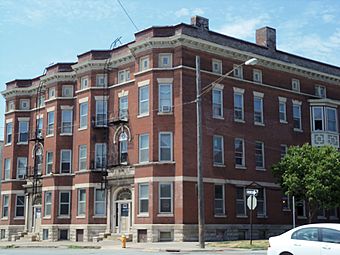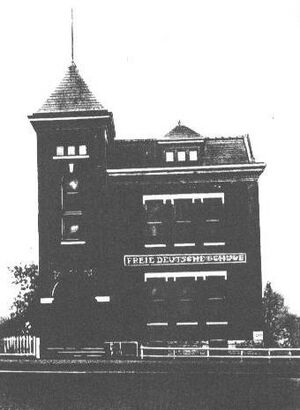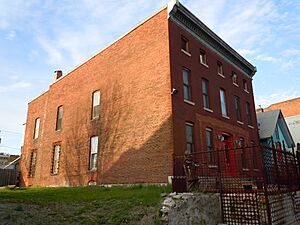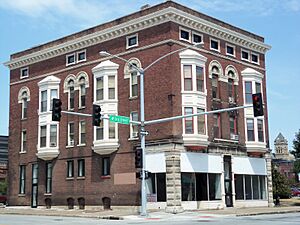West Third Street Historic District (Davenport, Iowa) facts for kids
Quick facts for kids |
|
|
West Third Street Historic District
|
|

Andresan Apartments
|
|
| Location | Roughly bounded by 3rd Street between Ripley and Myrtle Streets, Davenport, Iowa |
|---|---|
| Area | 21 acres (8.5 ha) |
| Architect | Multiple |
| Architectural style | Early Commercial |
| MPS | Davenport MRA |
| NRHP reference No. | 83003741 |
| Added to NRHP | November 18, 1983 |
The West Third Street Historic District is a special area in downtown Davenport, Iowa, USA. It was added to the National Register of Historic Places in 1983. This historic district links the main downtown area with the West End neighborhoods. It's important because of its strong connection to the German-American community in Davenport. Germans were the biggest group of people from other countries to settle here.
Contents
A Look Back: German Settlers in Davenport
Many German immigrants started moving to Davenport in the late 1840s. By 1850, nearly 3,000 Germans lived here. This was about 20% of the city's total population!
German immigration stayed strong through the 1880s. In 1890, about a quarter of all people in Scott County, Iowa were from Germany. A lot of these immigrants came from a region called Schleswig-Holstein. This area was having problems with Denmark in the 1840s. Other Germans came from places like Bavaria, Hamburg, Hanover, and Mecklenburg.
Washington Square: A German Community Hub
Washington Square was a city block planned by Davenport's founder, Antoine Le Claire. By the 1850s, it became the center of German cultural life. The Germania Gasthaus, a place where many immigrants first stayed, was nearby.
The Deutsch Theatre and the Central Turnverein (a German gymnastics club) were also on Third Street. These buildings are not there anymore. The square itself had a fountain with a statue of the Lady of Germania. It was a popular spot for German beer gardens, outdoor music, and community events.
Today, the downtown YMCA stands where Washington Square used to be. In 2006, a new park was built near the Rock Island Centennial Bridge. It has a new statue of the Lady of Germania. This statue looks like the old one that was in the square. The Lady of Germania is an old symbol of strength, unity, and freedom. She also reminded many people of their home country, Germany.
German Schools and Ideas
Some German immigrants in Davenport were "free thinkers." This meant they had ideas that were often against traditional church teachings. They did not want church-run schools. Instead, they started the Freie Deutsche Schule (Free German School) in 1852.
This school taught children for 35 years. It focused on a separate German culture that valued non-religious ideas. Not all German immigrants agreed with these views. Many also started church schools, like at Trinity Lutheran Church and St. Joseph Catholic Church.
Life on West Third Street
Washington Square and the West Third Street Historic District had many buildings with small shops. Above these shops, people lived. Sometimes, the shop owner lived there. Other times, the space was rented out for extra money.
Most buildings on West Third Street were built between the 1850s and 1900. This was a working-class area. Besides shopkeepers, many residents worked in factories and mills along the Mississippi River. The German feel of the area changed after World War I. This was because of strong anti-German feelings at the time. As the 20th century went on, larger buildings were built closer to downtown. The areas further west began to decline.
Building Styles in the District
The West Third Street Historic District has many types of buildings. You can see small shops, single-family homes, double houses, row houses, and apartment buildings. This mix of uses and building types makes the district special. You won't find this unique character anywhere else in Davenport.
The buildings are generally simple in design. Many are one or two stories tall with a "side-gable" roof. This means the roof slopes down on two sides. They could be expanded in the back, like a saltbox house. Or they could be made longer on one or both ends. Most houses are on the west side of the district. The commercial buildings (shops) are more common on the east side. Most of these buildings were built between the 1850s and the 1920s.
Older Styles and Features
The oldest buildings in the district often have a "side-gable" roof. They are built in a simple, local style called "vernacular Greek Revival." These buildings were used for many things. They were single-family homes, shops with apartments above, duplexes (two homes in one building), and rowhouses. Some commercial buildings also show a simple "Italianate" style.
Later Buildings and Apartments
Toward the end of the 1800s, bigger buildings were constructed near downtown. These often had more fancy storefronts and apartments above. Large brick apartment buildings were also built around this time.
The commercial buildings were usually three to three and a half stories tall. They had cast iron fronts for the shops. The upper floors had window bays that stuck out. The side walls between buildings sometimes had recessed "wells" for windows. The large apartment buildings are similar to others in the city. Many were built on high basements. They had window bays and sometimes decorative doorways and cornices (decorative tops). Some buildings had a main entrance leading to a central staircase. Others had two entrances, leading to separate apartments on each side of a shared wall. These often looked like mirror images, similar to double houses.
Important Buildings in the District







